I still remember the day I unboxed my first power bank, a shiny little gadget that promised to save me from the endless “battery low” panic. I thought, “How hard can it be?” Turns out, not hard at all, but also not something you want to do wrong the first time.
If you’ve just bought your first power bank and are staring at it like it’s a spaceship control panel, don’t worry. You’re in the right place.
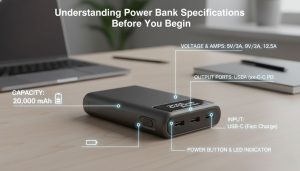
In this guide, I’ll walk you through exactly how I use a new power bank from its first charge to long-term care.
Here’s a quick look at what you’ll learn:
- How to charge your power bank for the first time
- How to charge your devices safely and efficiently
- Common mistakes to avoid
- Smart habits that extend battery life
- Handy FAQs for beginners
Let’s get started because a dead phone battery is no one’s friend.
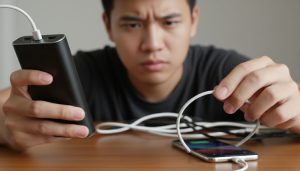
How to Charge Your Power Bank for the First Time
If you’ve just unboxed your new power bank, your first instinct might be to plug in your phone right away. But before you do that, give your power bank some attention. The first charge matters; it’s like giving your new gadget a proper “hello.”
Here’s my step-by-step method for the first-time setup.
Step 1: Read the Power Bank User Manual
I know manuals are often the most ignored booklet in the box. But this one deserves at least a quick glance.
Every power bank model has slightly different requirements. The manual tells you exactly:
- What kind of charger and cable does it need
- How fast it charges (input power rating)
- Whether it supports Power Delivery (PD) or Quick Charge (QC)
- If it starts charging automatically or needs a power button press
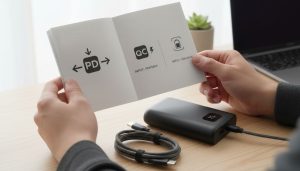
Skipping this step can result in slow charging or, worse, reduced battery efficiency.
Step 2: Use the Right Cable and Adapter for Your Power Bank
Once you know what your power bank needs, use only compatible accessories.
If you have a cable with the power bank, great, stick with it. If not, choose a certified high-quality USB-C or USB-A cable from a reliable brand.
Avoid connecting to low-powered laptop USB ports. They often deliver just 0.5A–1A, which means you could be waiting all day for a full charge.
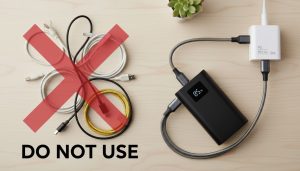
A wall adapter that supports at least 18W or 30W PD will charge most models efficiently.
Some newer ones, like the Anker Power Bank (25K, 165W, Built-In Cables), come with integrated retractable cables to hunt for the right wire in your bag.
Step 3: Fully Charge the Power Bank Before First Use
Most new power banks arrive partially charged (around 40–60%) for storage safety. Before using it, plug it in and let it hit 100%.
That first full charge helps the internal battery management system calibrate properly. It ensures you get accurate percentage readings and full capacity on your first use.
When it’s fully charged, unplug it. Keeping it connected for hours after 100% generates heat, which slowly wears down the battery over time.
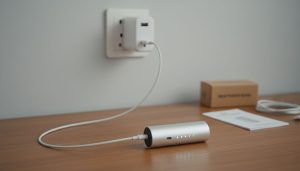
If your model has a display screen, even better, it’ll show the battery percentage and estimated charging time.
How to Use a Power Bank to Charge Your Devices
Now that your power bank is ready, it’s time to charge your devices.
The process is simple, but there are a few small habits that make a big difference in charging speed and battery health.
Here’s how I do it.
Identify the Output Port Type
Power banks come with different output ports, like:
- USB-A: Standard rectangular port, found on most older devices.
- USB-C: Newer, faster port supports both input and output.
- Lightning: For Apple users (though rare on most power banks).
Make sure your device cable matches the port type. If your phone supports fast charging, connect it to the USB-C or PD port for the best results.
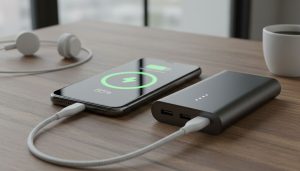
Connect the Device Securely
Plug your cable into the power bank and your device. The connection should feel snug, not loose or wobbly.
Avoid using damaged cables. Frayed wires can cause poor charging efficiency or even damage your device.
If you’re on the go, keep both devices stable. Constant tugging on the cable weakens the port over time.
Start Charging Automatically or Manually
Some power banks start charging automatically once they detect a device. Others need a power button press to begin.
If nothing happens, press the button once or hold it for 2–3 seconds. You’ll usually see LED lights blink or a small display turn on.
That’s your confirmation that charging has started.
Disconnect After Charging
Once your phone or tablet reaches 100%, unplug it. Keeping it connected longer doesn’t help; it actually drains a bit of the power bank’s charge.
Also, don’t wait for your power bank to hit 0% before recharging. Keep it between 20% and 80% for the healthiest battery cycle.
How to Know If Your Power Bank Is Charging
Wondering if your new power bank is charging correctly? Here’s what to look for:
- Flashing LEDs: Charging in progress.
- Solid lights: Fully charged.
- Digital display: Some models show percentage or time remaining.
- No lights: Could be a bad cable, port, or adapter.
If the indicator doesn’t respond, try changing the USB port or using another cable. Most “dead” power banks are just victims of poor cable quality.
Tips to Extend the Lifespan of Your Power Bank
After years of using power banks daily, I’ve learned that how you treat the battery matters just as much as how often you use it.
Here are the habits I follow to keep mine going strong.
Don’t Fully Discharge or Overcharge
The sweet spot is between 20% and 80%. Fully draining or constantly charging to 100% accelerates wear.
This small habit alone can double your power bank’s usable lifespan.
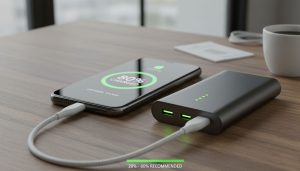
Avoid Extreme Temperatures
Heat is a silent battery killer. So it is freezing cold.
Store and charge your power bank in a cool, dry place, ideally between 0°C and 25°C (32°F–77°F).
Avoid leaving it inside a hot car or in direct sunlight. That’s the fastest way to shorten its life.
Use Quality Charging Accessories
It might sound repetitive, but it’s that important. Poor-quality chargers or cables cause irregular voltage flow, damaging both your power bank and your phone.
Stick to trusted brands or the accessories included with your device.
If you’re curious about how different power systems work, https://pickerzen.com/how-to-use-a-power-bank-charger/ breaks down how charging technology manages current flow in everyday devices.
Unplug When Fully Charged
Even with overcharge protection, a connected charger still produces heat after 100%. That heat slowly wears down battery cells.
If your power bank doesn’t automatically shut off, make a habit of unplugging once it’s full.
Keep Ports and Vents Clean
Dust build-up inside ports reduces contact quality.
Once a month, use a soft brush or compressed air to gently clean the USB ports. Avoid metal tools they can short the terminals.
Don’t Charge and Discharge at the Same Time
Some people charge their power bank while it’s charging their phone. That’s called pass-through charging, and not all models support it safely.
Unless your manual confirms it’s safe, avoid doing this regularly. It creates excess heat and shortens lifespan.
Common Mistakes to Avoid
Even if you’re careful, a few habits can silently damage your power bank. Here are the most common pitfalls I’ve seen (and learned from the hard way):
- Using weak adapters or cheap cables
- Leaving it plugged in overnight unnecessarily
- Keeping it in hot places (like the dashboard or under a pillow)
- Ignoring strange heat or swelling
- Charging wet or damp devices
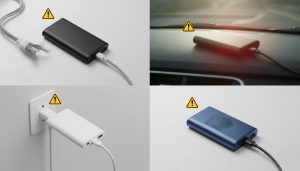
A power bank is built for durability, not abuse. Treat it with care and it’ll serve you faithfully for years.
When to Replace Your Power Bank
Every battery has an expiration date, even the good ones.
You might need a new one if you notice:
- It takes unusually long to charge
- It doesn’t hold a charge as well as before
- It gets warm during light use
- LED lights flicker or behave inconsistently
Most power banks last between 300–500 full charge cycles, depending on usage. After that, you’ll see a gradual capacity loss.
When it’s time to upgrade, go for one that supports modern features like USB-C PD, GaN fast charging, or multiple device outputs.
Safety Tips You Should Never Ignore
Power banks are safe when handled correctly, but a few simple rules go a long way:
- Never expose it to water or extreme heat
- Don’t puncture or open the casing
- Avoid charging near flammable materials
- Don’t cover it while charging (it needs airflow)
- Keep away from small kids and pets; those LED lights are way too tempting
If your power bank ever feels hot to the touch, stop using it and unplug it immediately.
FAQs: Quick Answers for Beginners
Q1. Should I fully charge my power bank before first use?
Yes. That initial full charge helps calibrate the battery management system, ensuring accurate charge readings.
Q2. How do I tell if it’s charging?
Check for blinking indicator lights or digital displays. Blinking means charging, solid means full.
Q3. Can I charge my phone and power bank at the same time?
Only if your power bank supports pass-through charging. Check your manual or the manufacturer’s site first.
Q4. Can I use my laptop to charge it?
Yes, but expect slower results. Laptops generally deliver low current (5V/1A). A wall adapter is faster.
Q5. How many times can I charge my phone?
That depends on the capacity. For instance, a 10,000mAh power bank can charge an average smartphone about twice.
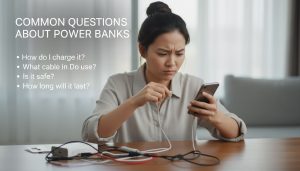
Conclusion
Using a power bank for the first time isn’t complicated, but doing it right makes all the difference.
Start by reading the manual, use the correct cables, charge it fully before the first use, and avoid habits that overheat or overcharge it.
Over time, you’ll notice how much smoother your charging experience becomes and how long your power bank lasts.
If you’d like a manufacturer’s detailed walkthrough of first-time setup and maintenance, I recommend checking Anker’s official guide. It’s a great technical companion to this user-level walkthrough.
And if you’re curious about renewable charging options, my solar power bank article is the perfect next read.

Your first power bank might feel like a small upgrade, but when that 1% battery warning pops up, you’ll realize it’s the little gadget that quietly saves your day.
Pingback: How to Use a Power Bank Charger Safely and Efficiently